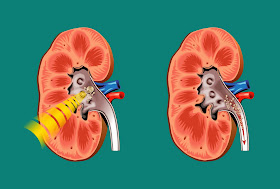This was some information given to me by my friend, who is a lady urologist.
The risk factors for the formation of kidney stones are:
- dehydration
- too much sodium intake
- decreased citrate intake
- too much oxalate intake
- family history of kidney stones
this is the chemical structure of oxalic acid--the base is called oxalate
Here are some sources, but not all sources, of oxalate in the diet.
Raw VegetableOxalate content (milligrams per 100 gram serving)*
- Spinach - 750
- Beet greens - 610
- Okra - 146
- Parsley - 100
- Leeks - 89
- Collard greens - 74
Here is the source of that table, and is a very nice article: http://www.whfoods.com/genpage.php?tname=george&dbid=48
My friend says that there are some people who are so concerned about kidney stone risk that they never eat spinach unless they have some cheese for the calcium in the cheese to bind the oxalate so it is not absorbed through the gut. (this way it never reaches the kidney)
She also says that if you have low calcium intake, then your bones release calcium into the system. This type of calcium puts you at very high risk for the formation of kidney stones. So take your calcium supplements!
To decrease your risk, take lots of foods that contain Citrate--citrus fruits are very rich in them.
Certain teas are very healthy too.
Here is the common clinical presentation of stones in the kidney, and what is routinely done for patients who have them.
The first symptom is PAIN.
Kidney stones are pain that is 10 out of 10
(for reference, the labor pain of childbirth is 9 out of 10)
We have two kidneys, one on the right, and one on the left.
The adrenal gland sits on top of each kidney.
The aorta is on the right in this picture, and the vena cava on the left,
this image is as if the patient is facing you.
Here is a close up of the kidney
You can see the collecting system (the renal pelvis) in the middle of the kidney
The ureter drains the kidney and is the beige tube on the lower left
The ureter and kidney are very painful when they stretch.
This is either from actual stone with spasm of ureter around it,
or from blockage from the urine flowing out, creating back pressure.
Here is where the kidneys are located in the human body.
They are very deep, and placed towards the back.
The kidney stone is visible in the right kidney
(on the left in this image, as the patient is facing you)
There are actually TWO stones.
Can you see them?
This is what some kidney stones look like.
I have also seen large ones that fill the entire kidney and are very spiky in appearance
These are called 'Staghorn' kidney stones.
Just to be sure everything is open, the urologist orders an IVP
or performs a retrograde study.
In the first, dye is given i.v. and filters through the kidneys into the urine (that is this photo).
In the second, the urologist injects dye up through the bladder all the way UP.
Lithotrypsy is the healing of stones by breaking them with intense sound energy.
Sometimes stones in the ureter cannot be removed because the sound will injure the delicate tissue.
Then a laser is used, usually a Holmium laser, in a different procedure.
This is a lithotryptor--on the lower right corner
Can you see the gel that is next to the kidney?
It has a series of shocks--sometimes thousands of them.
(The thing on the top is the c-arm for x-ray visualization of the stones as they break down)
General anesthesia is required for this procedure.
If you would like to know more about kidney stones, and how to avoid them, here is another excellent source: http://my.clevelandclinic.org/urology-kidney/diseases-conditions/kidney-stones-oxalate-controlled-diet.aspx
Is there an Archangel Raphael healing code for the kidney stones yet? No.
How about Reiki for the condition? It can't hurt.
Is Reiki a substitute for medical care?
No.
Use your higher guidance, your inner knowing, to find out what it right for you.
Ah, yes, also, spirit wants me to share that often we place 'stents' or little tubes--in the ureters to keep the urine flow open and from blocking again. They are temporary and can be removed at a later time.
I hope this has been helpful to you.
Aloha and Mahalos,
Namaste,
Peace,
Reiki Doc
* = Adapted from the following sources: (1) United States Department of Agriculture, Human Nutrition Information Service, Agriculture Handbook Number 8-11, "Composition of Foods: Vegetables and Vegetable Products." Revised August 1984; (2) data gathered by LithoLink Corporation, a metabolic testing and disease management service for kidney stone patients, founded by Dr. Fredric Coe, a University of Chicago Medical School Professor, and posted on its website at www.litholink.com; (3)data presented by Holmes RP and Kennedy M. (2000). Estimation of the oxalate content of foods and daily oxalate intake. Kidney International(4):1662.












